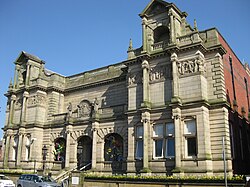 | |
 | |
| Established | 1973 |
|---|---|
| Location | Bolton Street, Bury BL9 0EY |
| Type | Transport museum |
| Owner | East Lancashire Railway |
| Website | http://www.eastlancsrailway.org.uk/plan-your-day-out/bury-transport-museum.aspx |
Bury Transport Museum is a transport museum in Bury, Greater Manchester, situated in the former Castlecroft Goods Warehouse, a Grade II listed building from 1846, [1] on Castlecroft Road, with the main entrance from Bolton Street, BL9 0EY.
It was started in 1973 by volunteers of the East Lancashire Railway, [2] had to close in 2003 because of roof problems but opened again in 2010. [3] Between May 2022 and early 2023 the museum had LNER Class A4 4488 Union of South Africa on static display. [4] The locomotive was removed on 21 April 2023.
In December 2023 LMS 3-Cylindered Stanier 2-6-4T No. 2500 was loaned to the museum from the National Railway Museum. [5] In March 2025 a World War one Memorial to the men of the Lancashire and Yorkshire Railway who died in military service was moved to the museum from Newton Heath Train Care Centre. [6]
- East Exterior
- Part of vehicles display
- Steam roller 'Hilda'
- Model of woman sitting on a station bench where visitors can also sit
- "Ann" taking part in Demonstration Shunting
- 60009 In the museum during being repainted
- Scammell Scarab next to Ann
- Footplate of "Union of South Africa"










